 Gilman Studio On-Line Lessons
Gilman Studio On-Line Lessons
Yang Style Long Form
Tai Chi Chuan
This Lesson Contains:
Congratulations and Movement # 55 – Step Up, Parry, And Punch
I think it is appropriate to offer congratulations to both you and me. We are now half way through the Long Form! It has taken about 11 months to post all these lessons. It took me a while to get up to steam, to learn how to do what I want to do. I think the lessons are improving. I expect that by the time I am finished the entire form, I’ll feel like going back and redoing it all over again. Because of this web course, I have changed the way I am doing my reference videotapes. I am producing new ones that match the web lessons, so they will be even more helpful as a learning tool. The new tapes will soon be offered through this web site. Watch for them.
Please feel free to come and join our free Saturday class in Port Townsend. A few web students have taken advantage of this opportunity. I like to meet the people who are following this along. I am so happy with the way this is growing. Each month, more and more people are visiting. You must be telling your friends, and that makes me happy. We have quite a ways to go, but it is not the destination that is important. It is the journey. So, let me know how you are doing and please offer any suggestions you can think might make this more effective for you and others.
Step Up, Parry, and Punch is a rather straightforward movement. The opponent punches with his right fist. I neutralize it to the right, and return a punch to his center. You can see illustrated here the principle of not confronting the energy directly. As the punch is thrown, I step up which means that I step to the side and into the opponent, letting the punch go by me. I can now deliver the return punch easily.
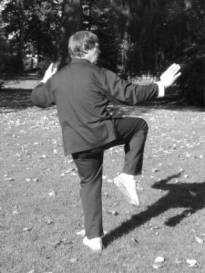
 Yoshi threatens from the front.
Yoshi threatens from the front.
Following the previous kick I pull the right leg back. The hands remain in the same place.
Focus on the energy returning to the center.
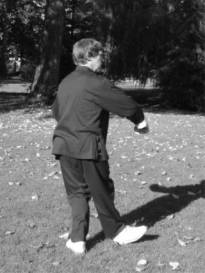
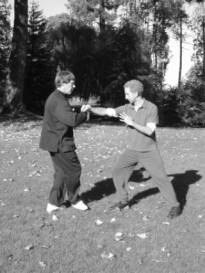 Yoshi punches with his right fist toward my center. I step up and join with his energy.
Yoshi punches with his right fist toward my center. I step up and join with his energy.
Set the right foot heel down near but slightly to the right and forward of the left foot. The right toe faces halfway between north and west. Keep the weight on the left foot. This could be a foot kick to the leg.
The right arm makes a clockwise circle by dropping down the front of the body to about waist level and forms a fist. The outside of the forearm faces to the left. Next, the right fist is brought over to the right side of the waist by pivoting at the elbow. The inside of the forearm now faces upward. This is the join, stick, and lead of the opponent’s punch over to my right side. I have closed him up by crossing his right arm across his body. My left hand has dropped to the left side of my chest. Focus on the right forearm.
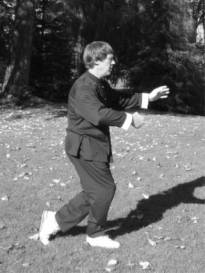
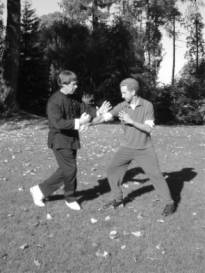 I lead Yoshi’s punch further away from his body and continue to close him up.
I lead Yoshi’s punch further away from his body and continue to close him up.
The weight is shifted onto the right foot and the left foot rolls up onto the toe. My torso is turning to the right and faces the same direction that the right toe does. It is important to turn the torso so that if the opponent’s punch were to land on your body, it would be a glancing blow.
The right fisted hand continues to stick to the opponent’s wrist. It stays by the right side of the waist. The left hand comes over to the center of the body with the palm facing to the right. It is now placed on the opponent’s elbow.
Focus on the right wrist for sticking and the left palm for joining.
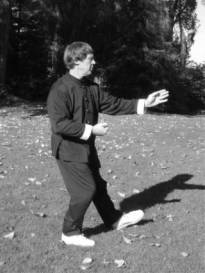
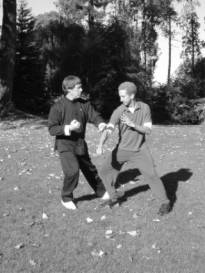 I step behind the opponent, open his center by parrying down his right arm with my left palm, and get ready to punch.
I step behind the opponent, open his center by parrying down his right arm with my left palm, and get ready to punch.
Step ahead with the left foot. The toe will face west. Don’t add weight to the foot yet.
The arms stay in the same basic position with a slight pressing down of the left hand.
Focus on the left arm for parry and the left foot for proper placement. Also, pay attention to gathering energy into the right Kua to support the punch.
Note: It is important to step with the left foot well to the left and forward. I want to make sure I step to the side of the opponent. If I step with my left foot inside his two feet, my stance will be too narrow to be a solid platform for delivering the energy.
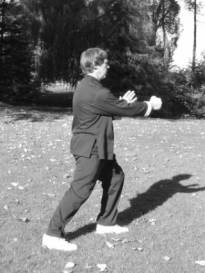
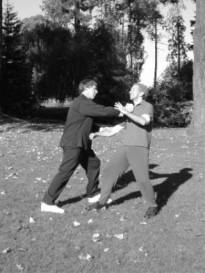 I deliver the punch.
I deliver the punch.
Shift the weight onto the left foot and turn the torso until the center faces west. Be sure the left knee just covers the toe.
The right arm extends. The fist turns from knuckles facing upward to knuckles facing to the left. The fist ends up on the right center of the chest. Be sure to keep the elbow drooped. The left hand moves backward to end with the palm facing the right elbow.
Focus on the punch.
Note: The left hand pulls back as the right fist punches out. This is a good example of Duei La, the balancing of forces. The left hand can pull the opponent towards you, or can twist the arm to hinder his balance.
